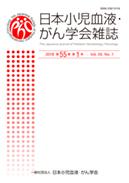Volume 53, Issue 5
Displaying 1-27 of 27 articles from this issue
- |<
- <
- 1
- >
- >|
JSPHO News
-
2016Volume 53Issue 5 Pages n_53-5_1-n53-5_2
Published: 2016
Released on J-STAGE: June 01, 2017
Download PDF (557K)
-
2016Volume 53Issue 5 Pages 337-341
Published: 2016
Released on J-STAGE: March 18, 2017
Download PDF (1712K)
-
2016Volume 53Issue 5 Pages 342-348
Published: 2016
Released on J-STAGE: March 18, 2017
Download PDF (4986K) -
2016Volume 53Issue 5 Pages 349-355
Published: 2016
Released on J-STAGE: March 18, 2017
Download PDF (740K) -
2016Volume 53Issue 5 Pages 356-364
Published: 2016
Released on J-STAGE: March 18, 2017
Download PDF (1961K)
-
2016Volume 53Issue 5 Pages 365-370
Published: 2016
Released on J-STAGE: March 18, 2017
Download PDF (922K)
-
2016Volume 53Issue 5 Pages 371-375
Published: 2016
Released on J-STAGE: March 18, 2017
Download PDF (3730K)
-
2016Volume 53Issue 5 Pages 376-383
Published: 2016
Released on J-STAGE: March 18, 2017
Download PDF (1470K)
-
2016Volume 53Issue 5 Pages 384-390
Published: 2016
Released on J-STAGE: March 18, 2017
Download PDF (8437K) -
2016Volume 53Issue 5 Pages 391-396
Published: 2016
Released on J-STAGE: March 18, 2017
Download PDF (12570K) -
2016Volume 53Issue 5 Pages 397-402
Published: 2016
Released on J-STAGE: March 18, 2017
Download PDF (782K)
-
2016Volume 53Issue 5 Pages 403-412
Published: 2016
Released on J-STAGE: March 18, 2017
Download PDF (14242K) -
2016Volume 53Issue 5 Pages 413-418
Published: 2016
Released on J-STAGE: March 18, 2017
Download PDF (4162K)
-
2016Volume 53Issue 5 Pages 419-427
Published: 2016
Released on J-STAGE: March 18, 2017
Download PDF (1685K)
-
2016Volume 53Issue 5 Pages 428-435
Published: 2016
Released on J-STAGE: March 18, 2017
Download PDF (1305K)
Original Article
-
2016Volume 53Issue 5 Pages 436-447
Published: 2016
Released on J-STAGE: March 18, 2017
Download PDF (905K) -
2016Volume 53Issue 5 Pages 448-452
Published: 2016
Released on J-STAGE: March 18, 2017
Download PDF (779K) -
2016Volume 53Issue 5 Pages 453-458
Published: 2016
Released on J-STAGE: March 18, 2017
Download PDF (2515K)
Case Report
-
2016Volume 53Issue 5 Pages 459-463
Published: 2016
Released on J-STAGE: March 18, 2017
Download PDF (825K) -
2016Volume 53Issue 5 Pages 464-468
Published: 2016
Released on J-STAGE: March 18, 2017
Download PDF (3768K) -
2016Volume 53Issue 5 Pages 469-473
Published: 2016
Released on J-STAGE: March 18, 2017
Download PDF (4353K) -
2016Volume 53Issue 5 Pages 474-476
Published: 2016
Released on J-STAGE: March 18, 2017
Download PDF (721K) -
2016Volume 53Issue 5 Pages 477-480
Published: 2016
Released on J-STAGE: March 18, 2017
Download PDF (720K) -
2016Volume 53Issue 5 Pages 481-486
Published: 2016
Released on J-STAGE: March 18, 2017
Download PDF (7104K) -
2016Volume 53Issue 5 Pages 487-490
Published: 2016
Released on J-STAGE: March 18, 2017
Download PDF (7519K)
Report
-
2016Volume 53Issue 5 Pages 491-494
Published: 2016
Released on J-STAGE: March 18, 2017
Download PDF (807K)
-
2016Volume 53Issue 5 Pages 495
Published: 2016
Released on J-STAGE: March 18, 2017
Download PDF (477K)
- |<
- <
- 1
- >
- >|
